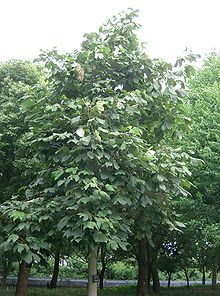| Chinese parasol tree | |
|---|---|

| |
|
Scientific classification
| |
| Kingdom: | Plantae |
| Clade: | Tracheophytes |
| Clade: | Angiosperms |
| Clade: | Eudicots |
| Clade: | Rosids |
| Order: | Malvales |
| Family: | Malvaceae |
| Genus: | Firmiana |
| Species: | F. simplex
|
| Binomial name | |
| Firmiana simplex | |
| Synonyms | |

Firmiana simplex, commonly known as the Chinese parasol tree, Chinese parasoltree, or wutong ( Chinese: 梧桐; pinyin: wútóng), is an ornamental plant of tree size assigned to the family Malvaceae that was formerly in the family Sterculiaceae in the order Malvales, and is native to Asia. It grows up to 16 m (52 ft) tall. [2]
Description
It has alternate, deciduous leaves up to 30 cm (12 inches) across and small fragrant, greenish-white flowers borne in large inflorescences. A flowering tree varies in fragrance with weather and time of the day, having a lemony odor with citronella and chocolate tones. A tall, stately specimen grows in the botanical garden in Florence, Italy. Bumble bees and Giant Mason Bees readily visit the flowers in Maryland, U.S. People grow this tree as an ornamental in warm regions of North America.
Uses
Due to its sonic properties, the wood is used for the soundboards of several Chinese instruments, including the guqin and guzheng.
According to an article in the journal Nature of 1884, the leaves of Sterculia platanifolia were dried for smoking; [3] the reason for smoking it was not given, but another source simply says that it was used as a substitute for tobacco. [4] [5]
The roasted seeds have reportedly been used to make into a tea. [6]
The Taivoan people in the Nanzixian River basin of Taiwan harvest the tough bark of 2–3-year-old trees. After soaking it by the river for about a month, they remove the rotted bark and twist the remaining fibers into ropes. These ropes can be used for making traps or other binding purposes, particularly for constructing wild boar traps. The robust nature of these ropes helps prevent the boars from escaping. [7]
Invasive species
This species is an aggressive, invasive weed in the warmer parts of North America [8] Some people promote its removal and give instructions for drastic measures, including destruction of nursery stock. This plant is self-fertile, and its seeds spread readily, especially along watercourses, growing rapidly after germination in favorable sites. Offspring effectively compete with many other species. [9]
References
- ^ "Firmiana simplex" at the Encyclopedia of Life
- ^ Ya Tang, Michael G. Gilbert & Laurence J. Dorr. "Firmiana simplex". Flora of China. Missouri Botanical Garden, St. Louis, MO & Harvard University Herbaria, Cambridge, MA. Retrieved 24 March 2013.
- ^ Anon, Nature, August 7, 1884, pp 337-338
- ^ "Read the eBook Useful plants of Japan, described and illustrated. By Bombay (Presidency). Government Central Museum online for free (Page 7 of 18)".
- ^ "Useful plants of Japan, described and illustrated". 1895.
- ^ Little, Elbert L. (1980). The Audubon Society Field Guide to North American Trees: Eastern Region. New York: Knopf. p. 603. ISBN 0-394-50760-6.
- ^ Mata Taiwan. "楠梓仙溪流域大武壠族民族植物:青桐樹" [Ethnic Plants of the Taivoan People in the Nanzihxian River Basin: Firmiana simplex]. Taiwan Cultural Memory Bank. Retrieved 2024-03-31.
- ^ "Controlling the Invasive Chinese Parasol Tree in St. Francisville, Louisiana and West Feliciana Parish".
- ^ Miller, J.H., E.B, Chambliss, N.J. Loewenstein. 2010. A Field Guide for the Identification of Invasive Plants in Southern Forests. General Technical Report SRS-119. Asheville, NC. United States Department of Agriculture, Forest Service.
External links
- Firmiana simplex - The University of Alabama in Huntsville
- Firmiana simplex - Louisiana State University
- Firmiana simplex - PlantList Retrieved 20210102